Love sauerkraut? This red cabbage sauerkraut is an easy lacto-fermentation recipe. All you need is red cabbage, salt, a glass jar, and a little time.
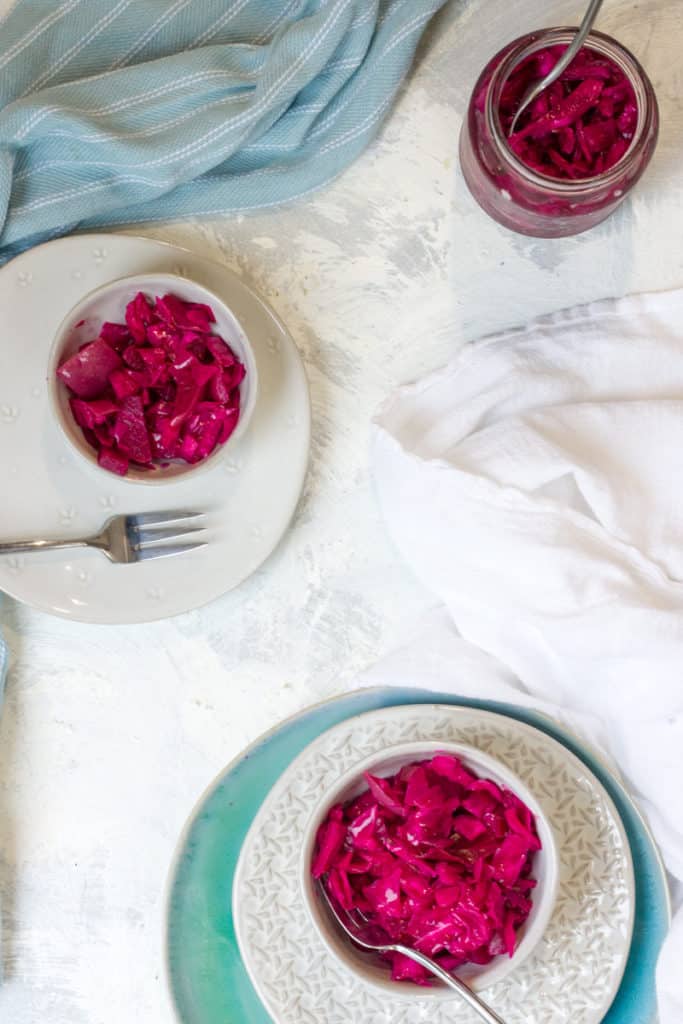
Stuck at home?
Now is the perfect time to try making your own sauerkraut. It's easy, requires almost no special fermenting equipment, and is a delicious way to preserve cabbage for later.
Typically, when I make homemade sauerkraut I use green cabbage, but red cabbage sauerkraut is just as delicious.
Plus, it gets bonus points for being pink!
Because we all know that red cabbage is not, in fact, bright red, but is instead a gorgeous purplish-pink. And that makes it fun.
What Equipment Do I Need?
You need a large glass jar or several small glass jars. I use one 2-quart (half-gallon) jar for each head of cabbage.
For the easiest possible fermenting experience, I recommend using airlock fermenting lids. I use these Easy Fermenter airlock lids, because they're inexpensive and require very little babysitting.
If you don't have airlock lids, you can also seal the jars with a lid and "burp" the jars daily to release pressure from the jar. This method requires daily check-ins, because building pressure within the jar can cause the jar to burst.
Alternatively, you can cover open jars with a kitchen towel or paper towel, and just leave them unsealed. This method is the cheapest and easiest; however, it can also be the smelliest, since there's nothing sealing in those sauerkraut scents.
You can also skip the glass jar entirely and use a fermenting crock instead.
What Ingredients Do I Need for Red Cabbage Sauerkraut?
You need a red cabbage and salt. That's it.
This sauerkraut is also delicious with herbs or spices added in, such as caraway seeds, thyme, or chives.
I like to mix in other root veggies, like diced turnips or radishes. Red cabbage sauerkraut is also delicious with diced apples.
What Makes Red Cabbage Sauerkraut Different?
The color, obviously! But seriously, the color.
Making red cabbage sauerkraut will stain your hands a little bit, so if you're headed to a job interview or a photoshoot afterwards, I recommend wearing gloves.
That said, I do not wear gloves when I make my red cabbage sauerkraut, and my hands are usually back to normal within a day or so.
Also, in my experience, store-bought red cabbage tends to be drier (releasing less moisture) than green cabbage.
I suspect that red cabbage sits in the produce section longer than green (because it costs more), and so the cabbage tends to be less fresh.
Dry cabbage will still work just fine for sauerkraut, but be aware that you might need to add a little salt and water brine. I'll walk you through how to do that in the recipe card.
How to Make Red Cabbage Sauerkraut
Start by removing the outer leaves from the cabbage. Save one or two, rinse them off, and set them aside.
Next, dice the cabbage.
You can do large (but still bite-size) or extra-small pieces, but it's important to keep the pieces fairly uniform so that they ferment at the same rate.
Keep in mind that larger pieces will take longer to ferment, but smaller pieces could become mushy more quickly. The size is totally up to you.
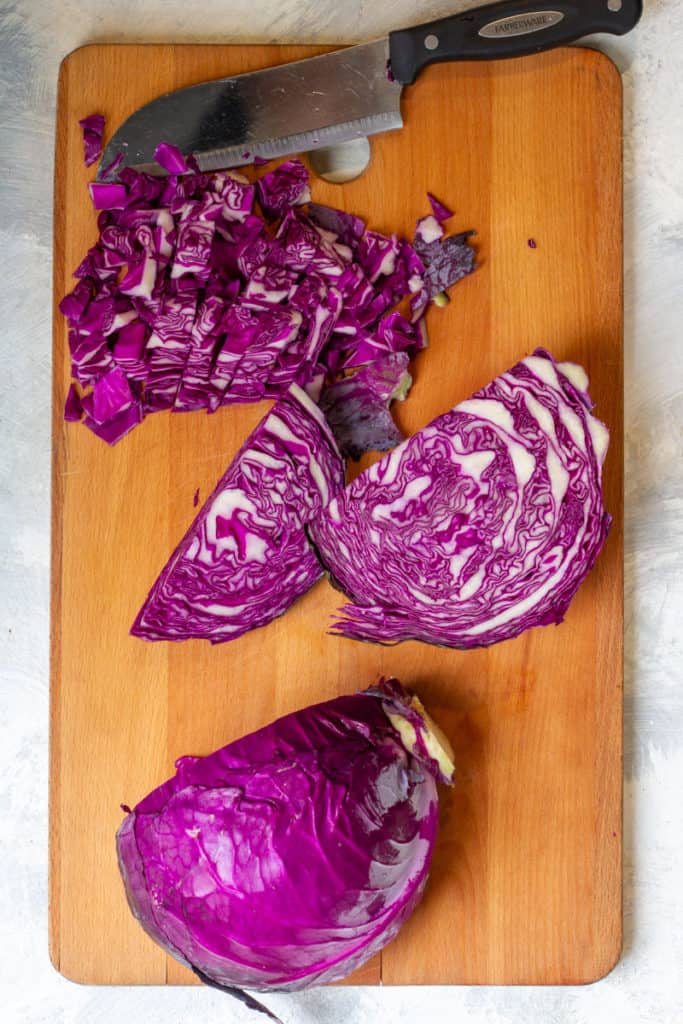
Add the diced cabbage to a large bowl, and sprinkle with salt.
Massage the cabbage with your hands until the cabbage releases its water.
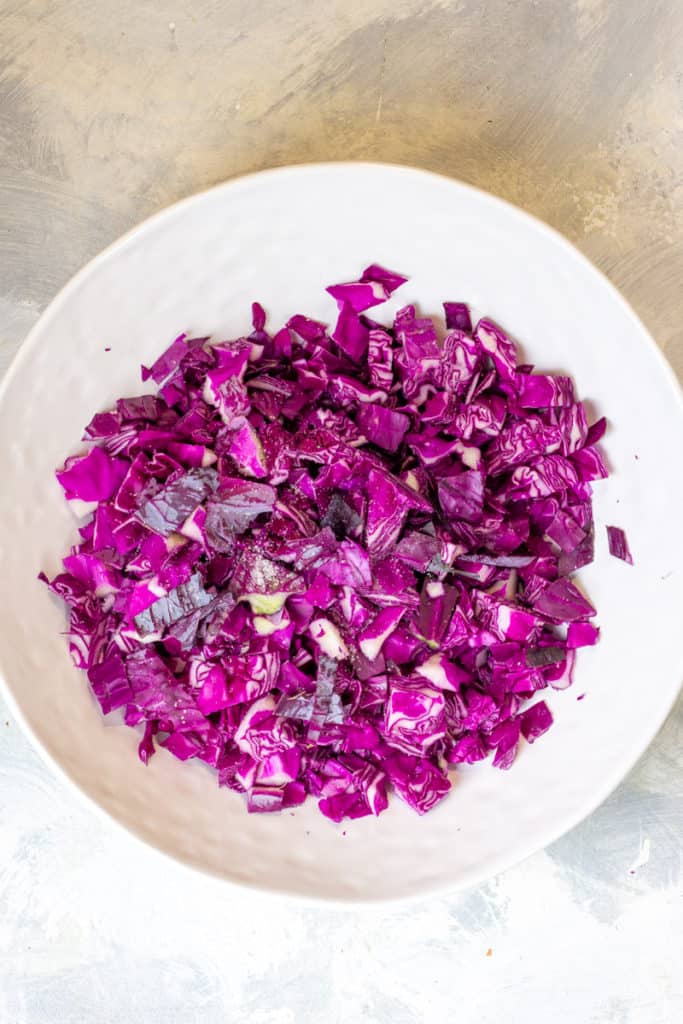
Rub it until you see water pooling in the bowl.
You should be able to take a handful of cabbage, squeeze it, and see liquid draining freely back into the bowl.
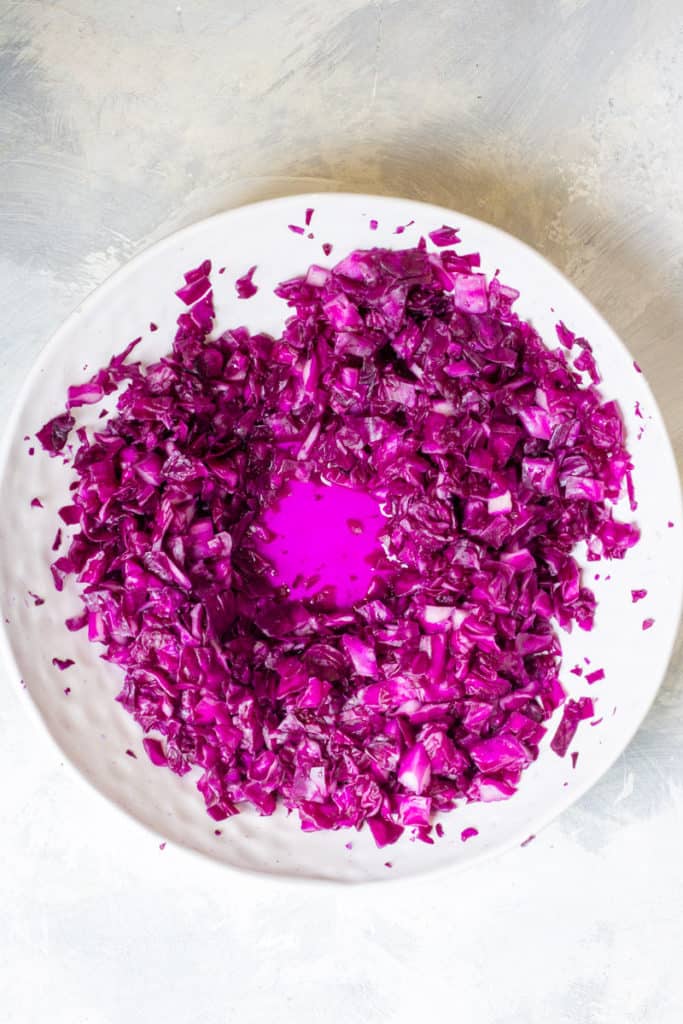
Massaging cabbage should not make your hands hurt.
If you work for several minutes and don't see enough liquid, add a little more salt, cover the bowl with a towel, and walk away. Try again after about 45 minutes.
If you're adding extra ingredients, stir them into the sauerkraut now.
Next, begin packing the sauerkraut into a glass jar.
Shove as much cabbage as possible into the jar, and then push the cabbage down with your fist, a fermenting tamper, a wooden spoon, or a pestle.
You want the cabbage to be below the liquid level. If it's not, follow the directions in the recipe card to make a water and salt brine.
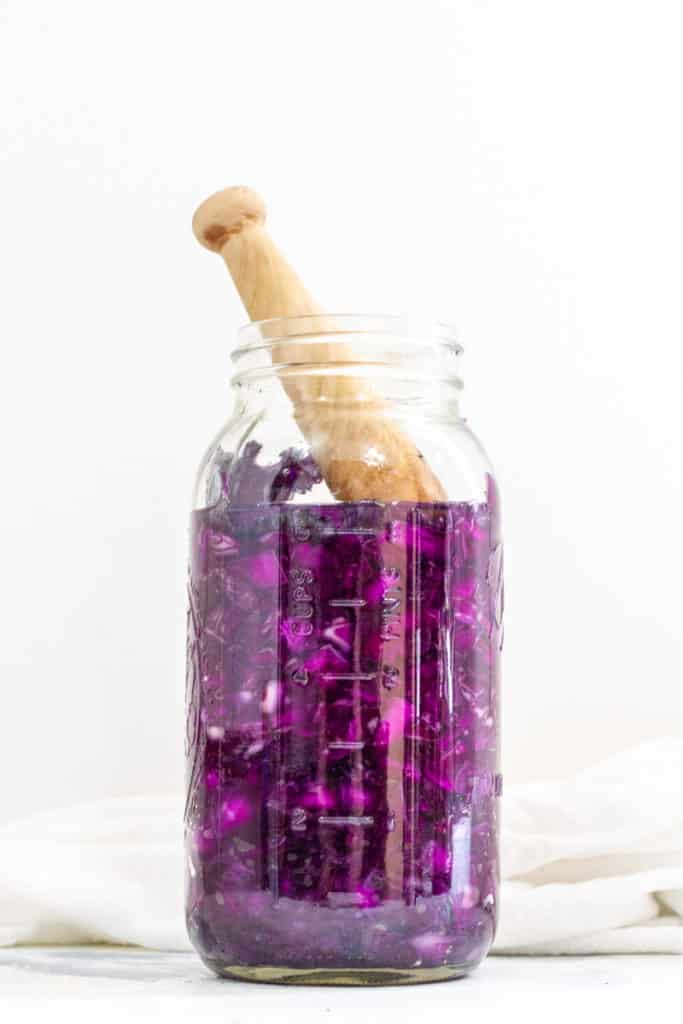
Top the cabbage with one or two of the reserved cabbage leaves. The cabbage leaf (or leaves) will help hold the diced cabbage below the liquid while it ferments.
Optionally, add a fermenting weight. You can buy a weight, use a stone that you've sanitized in boiling water, or add a sealed glass jar full of water.
When I use my airlock fermenting lids, I skip the weight. If I'm not using an airlock lid (because I'm fermenting too many things at once and ran out of lids), I use a small glass jar.
Next, seal the jar. Or don't seal the jar and cover it with a towel.
In the photo below, I sealed the jar with an airlock fermenting lid.
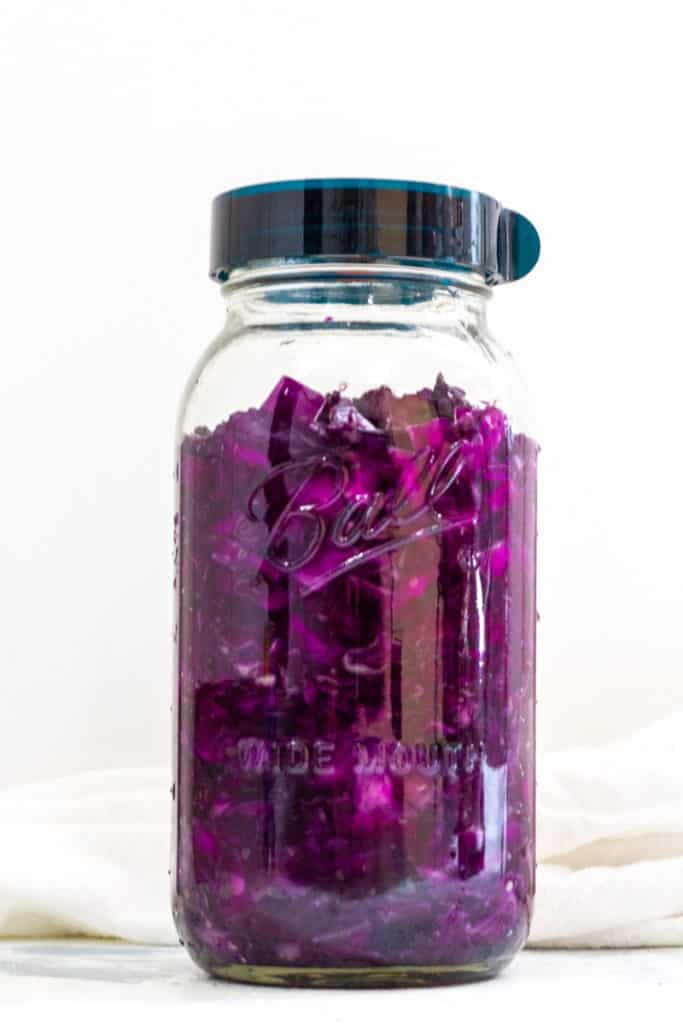
Set the jar out of direct sunlight, in a place where you'll easily see it every day.
Check the jar daily to ensure that the liquid is above the cabbage. If it's not, push the cabbage back down.
How Long Does It Take To Ferment Sauerkraut?
After about four days, start tasting the sauerkraut. When you like the flavor, it's ready.
I like my sauerkraut when it's fermented for about two weeks, but you could let it ferment for months if you want to. Just make sure to continue doing daily checks to make sure the liquid is above the cabbage.
How to Store Homemade Sauerkraut
Once you like the flavor of the sauerkraut, scoop it into smaller jars. Top each jar with some of the liquid from the larger jar.
Keep in mind that the pink liquid in the jar will stain your clothes or kitchen towels. Work carefully.
If you're not using it immediately, add a small piece of wax paper (or a cabbage leaf) to press the sauerkraut in each small jar below the liquid. Store it in the fridge and use it within a year.
How to Use Red Cabbage Sauerkraut
Use red cabbage sauerkraut anywhere that you'd use regular sauerkraut!
Serve it as a side dish (cold or hot). It's also pretty delicious stirred into a veggie pasta sauce, or served with a slice of buttered rye bread.
Sauerkraut is also perfect with seafood! I like it using it instead of shredded cabbage on these easy fish tacos, and any type of sauerkraut is delicious on this cod reuben. It's also pretty perfect on a classic reuben sandwich.
However you serve it, dig in and enjoy!
Red Cabbage Sauerkraut
Equipment
- Large Glass Jar (2 quarts minimum), or Multiple Smaller Jars
Ingredients
Red Cabbage Sauerkraut:
- 1 red cabbage (~3 lbs)
- 1 ½ tablespoon sea salt
Optional Extras:
- 2 tablespoons caraway seeds (more or less as desired)
- apples, turnips, radishes, or carrots (as many as you like), diced into small pieces
Instructions
Prepare the Cabbage:
- Remove the coarse outer leaves from the cabbage. Pick one or two unblemished leaves, rinse them off, and set them aside for later. Discard (or compost) the remaining outer leaves.
- Chop the cabbage into uniformly bite-sized pieces. Chop by hand or in a food processor. If using a food processor, take care not to pulverize the cabbage.Sizing Tip: You can use either large or very small pieces of cabbage. Large pieces will take longer to ferment, but very small pieces could become mushy more quickly. How large or small you chop your cabbage is up to you.
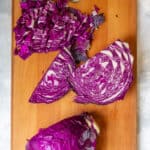
Massage the Cabbage:
- Add the cabbage to a large bowl. Add the salt.Use your hands to massage the salt into the cabbage. As you work, the cabbage will soften, turn a brighter pink, and will begin to release liquid.Tip: Note that the liquid will be pink, and may stain your hands (and bowl, and countertop). Avoid using any bowl or countertop area that may stain. Wear gloves if desired.
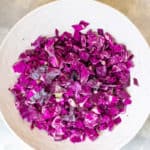
- Continue to massage the cabbage until water pools in the bowl. You should be able to lift a handful of cabbage, squeeze it, and see the liquid flowing freely back into the bowl.Tip: If the cabbage is not releasing liquid, cover the bowl, let it sit about 45 minutes to an hour, and try again.
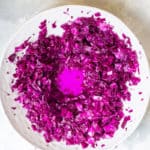
- If adding caraway seeds, fruit, and/or vegetables, mix them in now.
Pack the Cabbage Into a Jar or Crock:
- Use your hands to transfer the cabbage into a clean glass jar or fermenting crock. Pour the liquid in the bowl on top of the cabbage.
- Use your fist, a tamper, or a large wooden spoon to press the cabbage down. The liquid should rise above the cabbage.Leave at least 4" of headspace between the cabbage and the top of the jar or crock.Tip: If you have a particularly dry head of cabbage, you can pour leftover brine from a previous batch of sauerkraut over the cabbage. Alternatively, mix up a batch of brine (ratio 1 gallon water to ½ cup salt), and add brine until the cabbage is submerged.

- Place one or two reserved cabbage leaves on top of the cabbage. Press down on the leaf to help keep the chopped cabbage submerged.
- If Using a Crock: Add the crock weights or a small plate, and place the lid on the crock.If Using a Jar: Jar Option 1: Weigh down the cabbage + Cover Jar with a Towel. Use a sealed glass jar filled with water (make sure it is small enough to be easily removed without breaking) or a sealed ziplock bag filled with water to weigh down the cabbage. If you weigh down the cabbage, you can simply cover the jar with a tea towel instead of sealing the jar.Jar Option 2: Seal the Jar. Twist the lid onto the jar and seal it. You'll need to burp the jar daily to release the carbon dioxide gasses that build up in the jar. (You can use this option with or without a weight.)Jar Option 3: Use an Airlock Lid (My Preference). A third option is to use a fermenting airlock lid. These lids eliminate the need to burp the jar, and can be used with or without weighing down the cabbage.
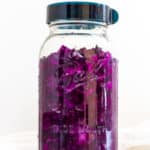
Ferment the Cabbage:
- Set the jar somewhere you'll see easily each day, but out of direct sunlight. Depending on how much headspace you left (and if you're not using an airlock fermenting lid) you may want to place the jar on a rimmed baking sheet to catch any liquid that overflows.Check on the sauerkraut each day to make sure the cabbage is still submerged below liquid. If it's not, open the lid and push it down below the liquid.If you used a jar with a sealed (non-airlock) lid, burp the jar each day (for the first few days) to release the carbon dioxide gasses. These could build and cause the jar to break.
- Begin tasting the sauerkraut after about 4 days. Fermenting can take anywhere from 4 days to 3 months, depending on your preference and the temperature of the fermenting room.As the sauerkraut ferments, the flavor will mellow and become less acidic-tasting. The texture will soften. It's done fermenting when you like the flavor and texture.
- When you like the flavor and texture, transfer the sauerkraut into smaller jars. If using within a week, simply add the sauerkraut to smaller jars.If you're not using the sauerkraut immediately, press the sauerkraut down into the jars, and top with a small piece of wax paper. Pour brine on top of the paper.Store the sauerkraut in the fridge and use within a year.


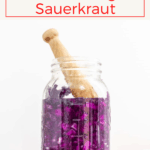




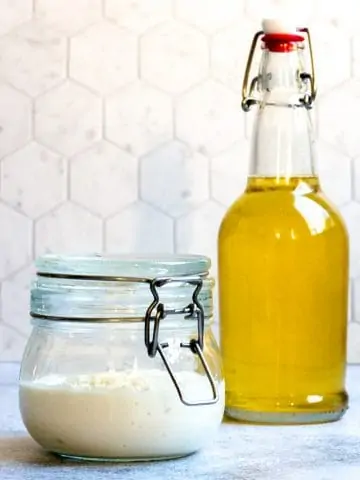
Dawn
HUGE sauerkraut fan over here so loving this recipe! Can't wait to try! And I know I'll be so tempted to eat straight outta the jar 😉
Sarah Trenalone
whoop! yay! I eat it straight from the jar too lol!
Misty
Got this ferment going right now. First time!
Alisha Trenalone
Yay! Hope it goes well.
-Alisha at Champagne Tastes